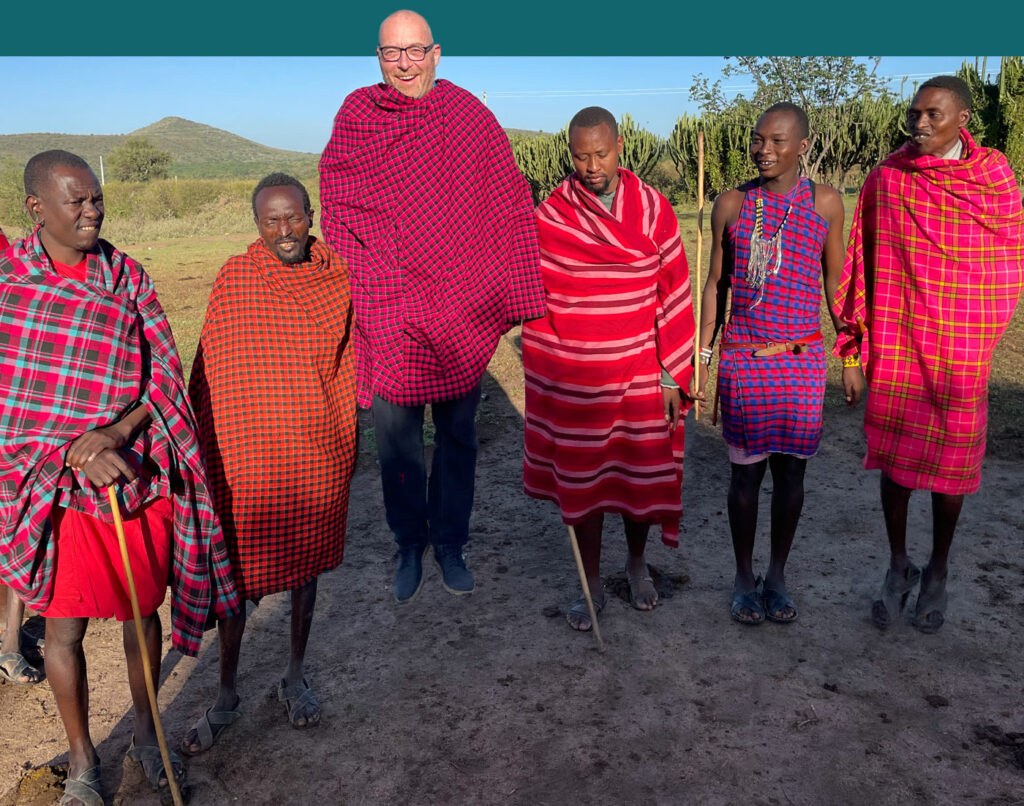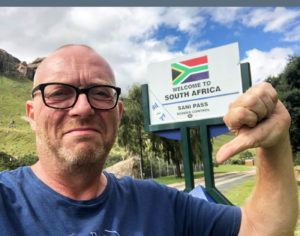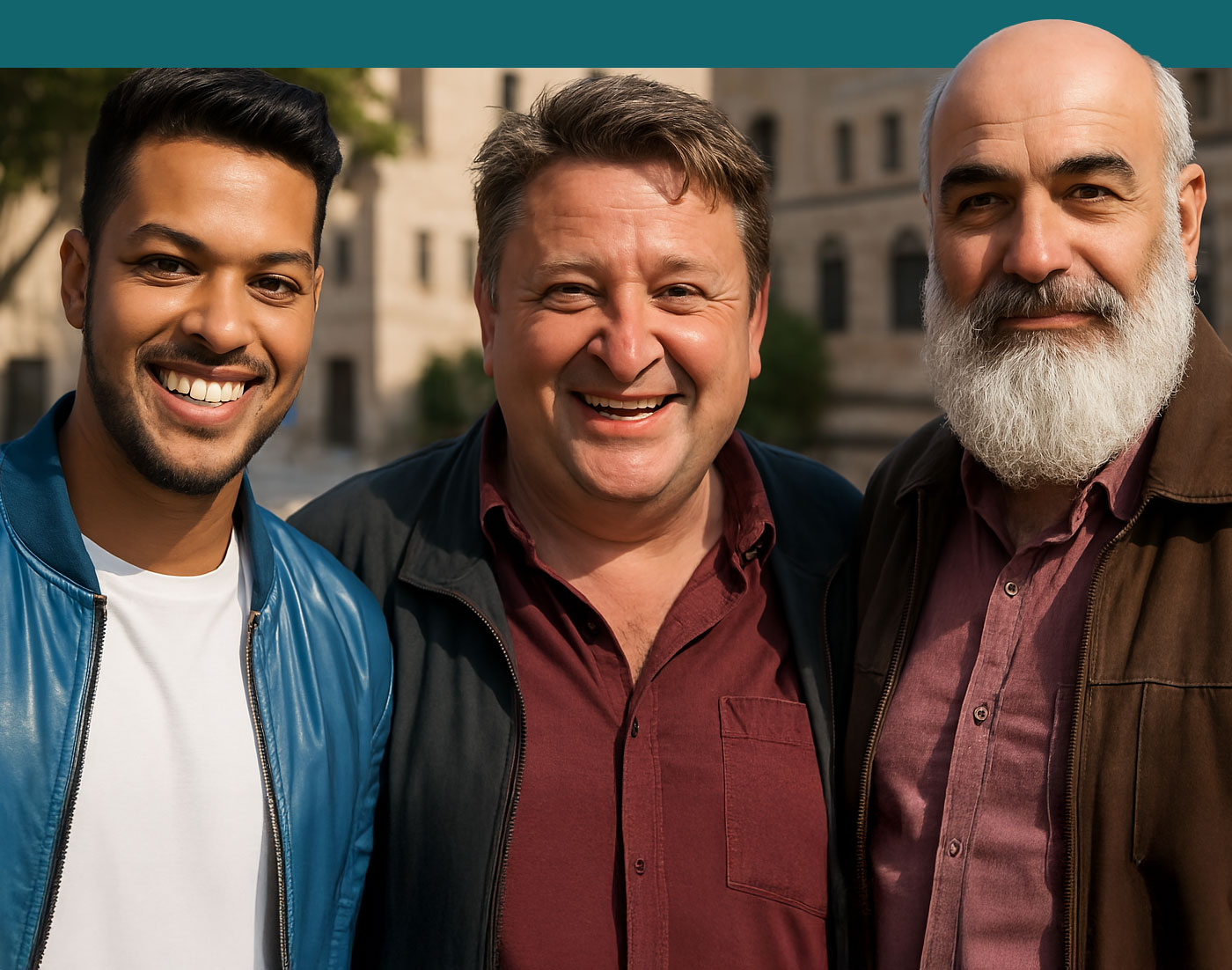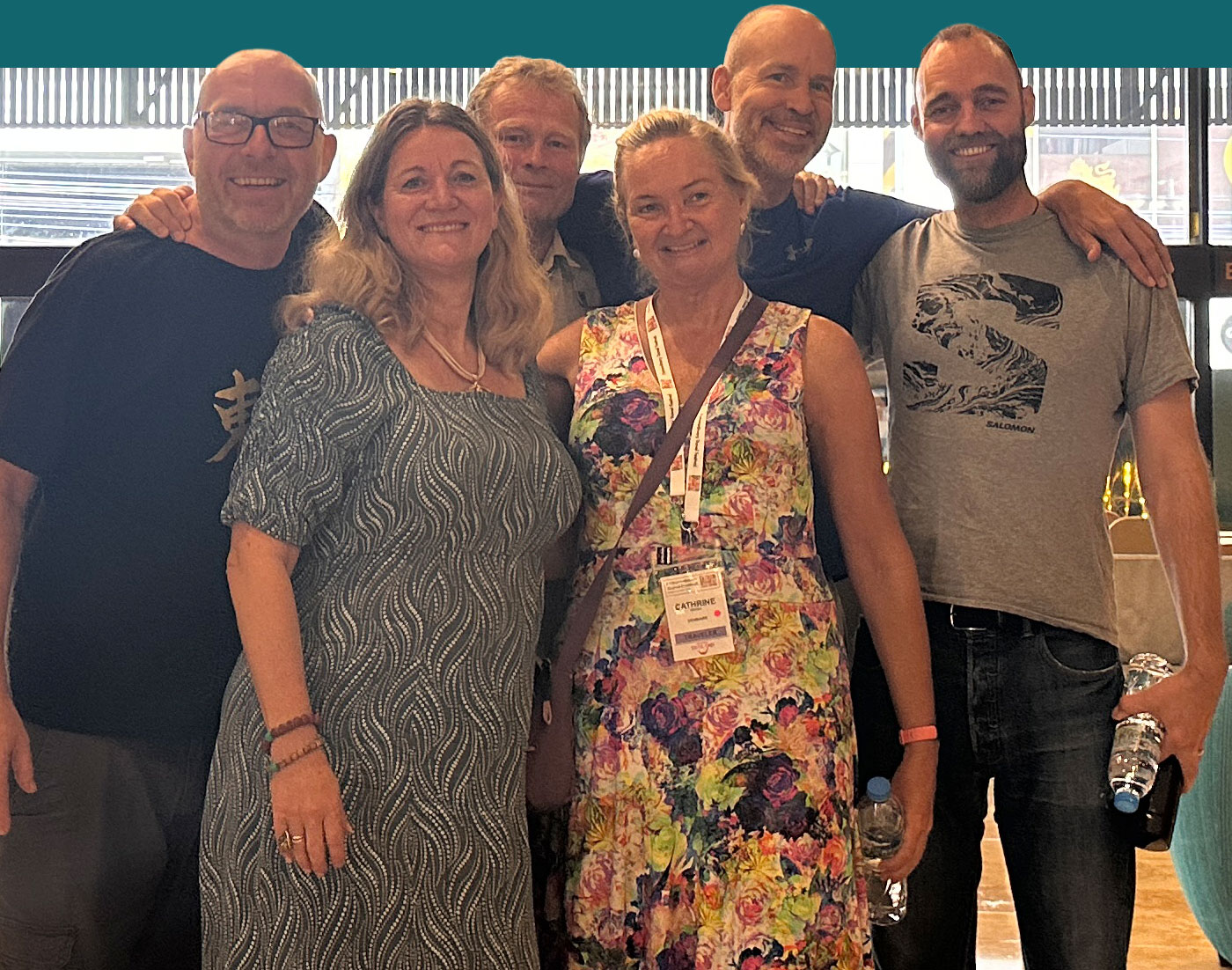Welcome to part 4 of my mini-series about Kenya and The Masai Mara. Click here to go to part 1, part 2, and part 3.
After our exciting hot air balloon trip, I went to the Maasai village in the Mara. This was my last day in the Mara. I had spent two nights in Lenchada Tourist Camp in the Masai Mara game reserve in Kenya. And when we were asked if we wanted to go for a visit to a real Maasai village, I was the only one in the group who was interested. So, I got a private tour for a few hours.
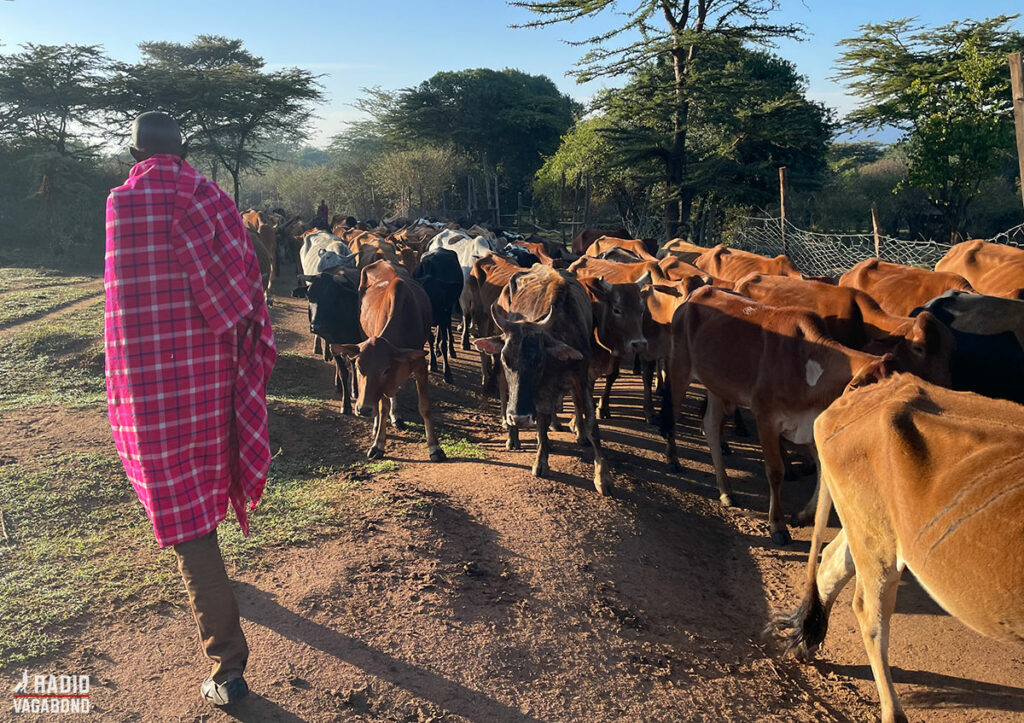
WELCOMING MAASAI
A young boy from the village picks me up, and after a short walk just outside the fence that surrounds their little village, I meet up with Sammy, who would be my guide for the tour.
A group of eight tall slim young Maasai men stood in a half-circle in front of me, singing, dancing, and jumping. They all wore their attractive colourful Maasai shuka – an African blanket they traditionally wear as a sarong. It’s thick enough to be used as a light blanket for chilly mornings and afternoons. Each Maasai does not wear the exact same colours, but most of them wear red because it symbolizes their culture, and they believe it scares wild animals away.
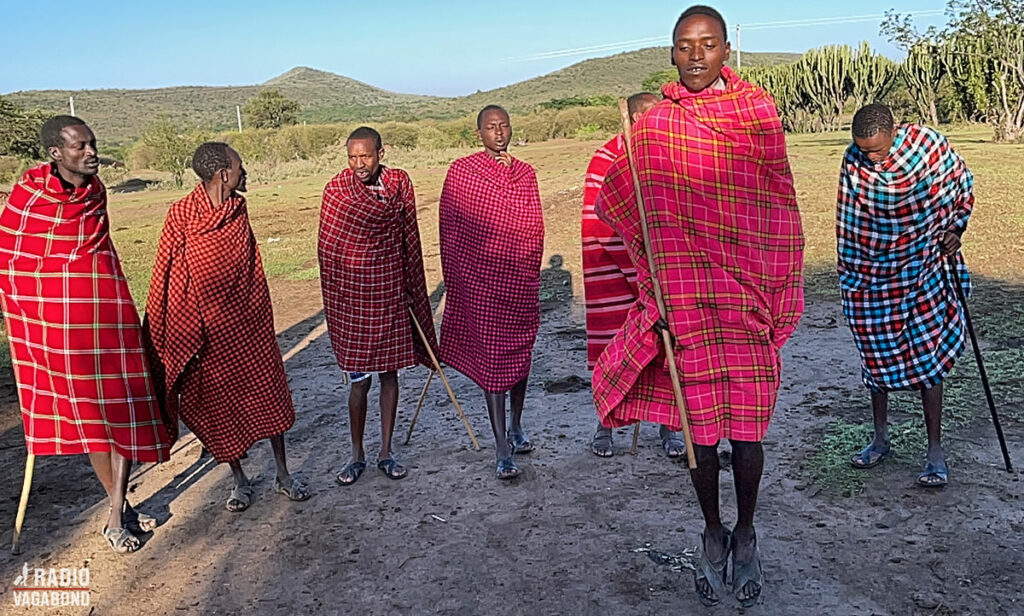
JUMP JUMP JUMP
They jump high, straight up in the air. Later I learned that the higher they can jump, the less dowry they pay to the woman’s family before marriage. The young Maasai men then invited me to join the dance. First, they draped me in a red shuka – and had a laugh watching this pale middle-aged, slightly overweight Scandinavian dude trying to jump. In the moment, I felt I did pretty good but looking at the pictures, I can see that I barely left the ground. So, it would be expensive for me to get married in this culture.

ONE BIG FAMILY
In this village, there were 20 families with 200 people from the same grandfather. They do not intermarry in their village. As mentioned, they are a semi-nomadic tribe that stay in the same place for around nine years, and they move to another place when the houses are eaten by termites. They are polygamous – which means that the man can marry as many women as he likes (or can afford).
6 FACTS ABOUT THE MAASAI PEOPLE
1. Most Famous African Tribe
The Maasai is an ethnic group living in northern, central and southern Kenya and northern Tanzania. They are among the best-known local populations internationally because they live in or near the many game parks of the African Great Lakes. And then we know them for their distinctive customs, dress, and beautiful jewelry. The men very often also have a distinct tall and slim frame. More on that later
2. Population
There are around 2 million Maasai people. 1.2 million are in Kenya and around 800,000 in Tanzania.

3. Language
The Maasai speak the Maasai language, Maa – but except for some elders living in rural areas, most Maasai people speak the official languages of Kenya and Tanzania, Swahili and English.
4. Body Modification
The piercing and stretching of earlobes are common among the Maasai as with other tribes, and both men and women wear metal hoops on their stretched earlobes.
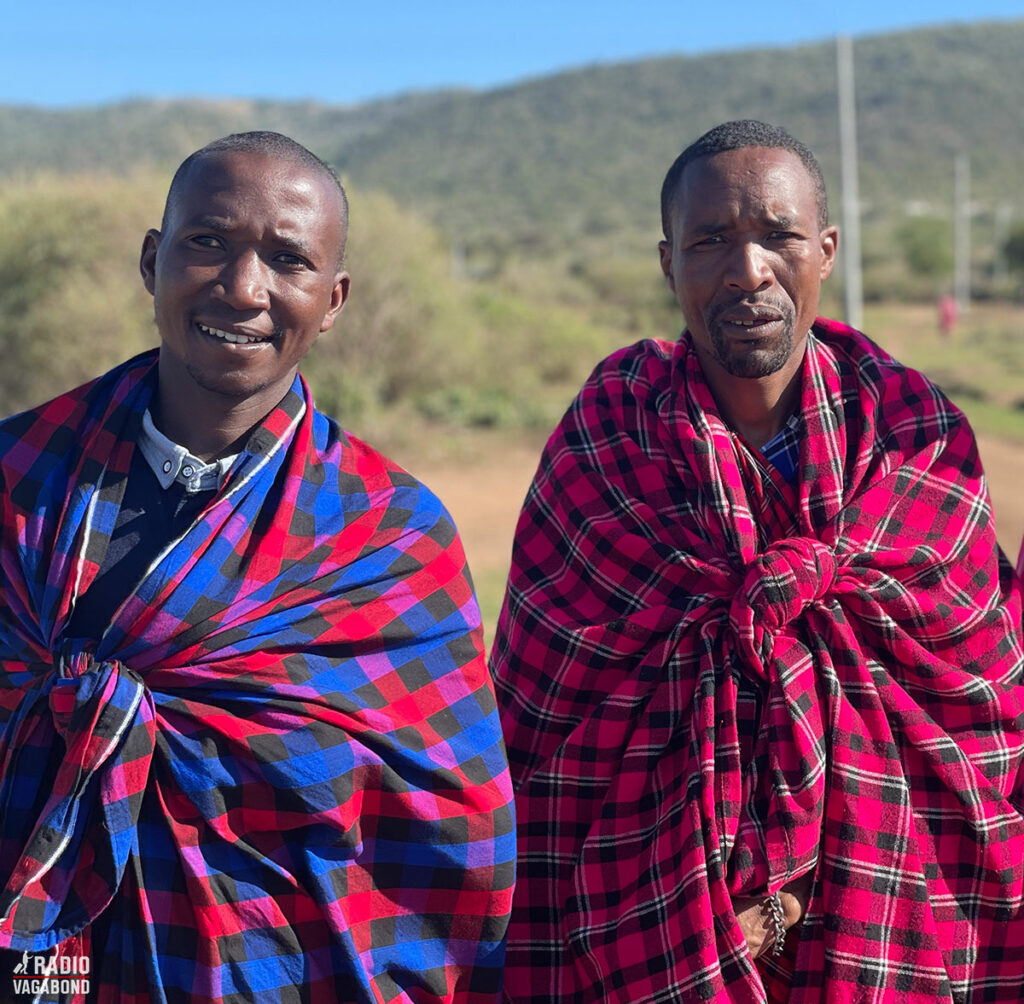
5. Tall People
They are considered one of the tallest people in the world. According to some reports, their average height is 6 ft 3 inches (190 cm).
6. When a Maasai Dies
They typically don’t bury people in the ground when they die – as they feel that it ruins the earth. They instead have a “scavenger burial” where they cover the dead body with oxblood or cattle fat and leave it in a bush for the wild animals to eat. The deceased is considered a good person if they are eaten on the first night.
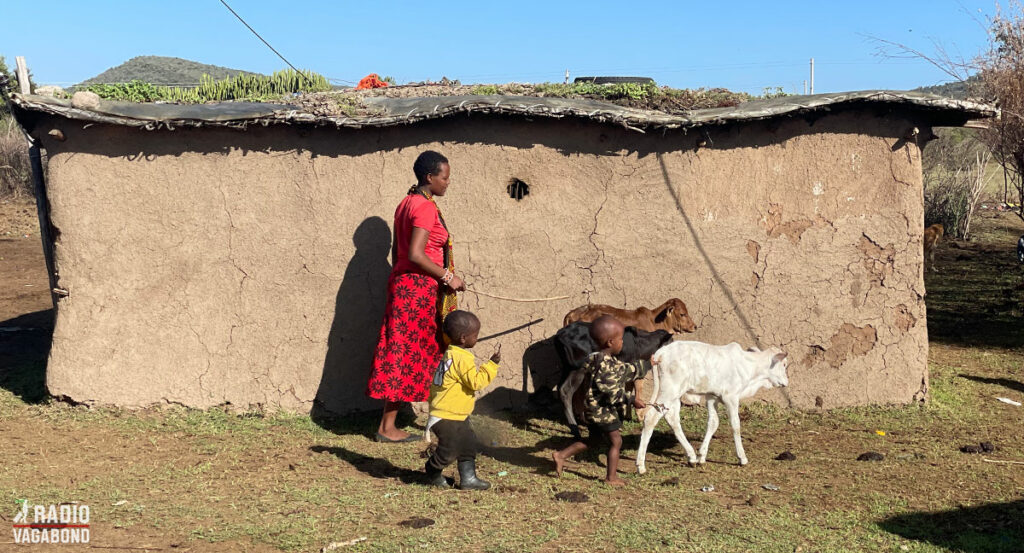
A LOOK IN THE HISTORY BOOK
The Maasai tribe has not had an easy life. According to Maasai belief, the tribe originated in northwest Kenya, just north of Lake Turkana. As they are semi-nomadic, the Maasai tribe lives off the land. After a few years in one place, they move to the next area to survive.
Before the European settlers arrived, the Maasai people owned almost all of the most fertile lands in Kenya. But their man-made spears were no match for armed British troops, so the Maasai tribe lost the battle for their best land in 1904 and signed their first agreement with the Europeans.
While their land was some of the best in Kenya, the Europeans were not content and further fought to get more. So, in 1911 a small group of Maasai signed another agreement giving up even more land. Despite not being fully understood, these Maasai were tricked into signing away valuable land. A total of around two-thirds of their land was lost, resulting in devastating consequences for the Maasai people.
POLYGAMY AND LION KILLING
Back in the Maasai village, Sammy told me more about Polygamy in the tribe. Sammy has four children and only one wife, but his father has eight wives. And eight mothers-in-law.
This is when I meet up with a group of other young men from the village, and they did a dance for me. They mostly dance during celebrations like initiations when a group of young buys hit puberty. They normally do the dance when they celebrate that the boys are old enough for circumcision and then go into the forest for a couple of years – and, according to Sammy, finish up with killing a lion.

According to Wikipedia and many other sources, it’s a common misconception that each young Maasai man is supposed to kill a lion before he can enter adulthood. They say that lion hunting was an activity of the past, but it’s been banned in East Africa and that lions are only hunted when they threaten the Maasai livestock. But according to Sammy, it still happens.
So, in other words, when the boys are around 15, they are circumcised and then go with a group of 30-50 boys and two elders from the village out into the forest and stay there for a couple of years. This practice is done every few years with boys from the same age set. Here, they learn how to be a Maasai warrior, how to hunt, jump, sing, make fire, and about herbal medicine, and according to Sammy, end up killing a lion.
Another young man, the 24-year-old Augustus, highlights that they don’t do it just for fun; it’s a tradition. Sammy mentions that he indeed has killed a lion, and sometimes, the experience can go both ways. The lion can kill you, or you can kill it. After you kill a lion, there is a celebration back in the village.
Genital Modification
Sammy and Augustus mentioned circumcision. This happens to both girls and boys to initiate them into adulthood. This ritual is typically performed by the elders, who use a sharpened knife and makeshift cattle hide bandages for the procedure.
The boy is expected to endure the operation in silence in the male ceremony. Even expressions of pain will “bring dishonour upon him”.
Any unexpected movements of the boy can cause the old Maasai with the sharp knife to make a mistake in the delicate process. This can result in severe lifelong scarring, dysfunction, and intense pain.
So, don’t make a sound, don’t move, and don’t even make a funny face when an old guy from your tribe chops off the tip of your penis without any kind of sedation. Ouch! If that doesn’t prove you’re a man, nothing will.
But for the Maasai, circumcision is a crucial public celebration of manhood.
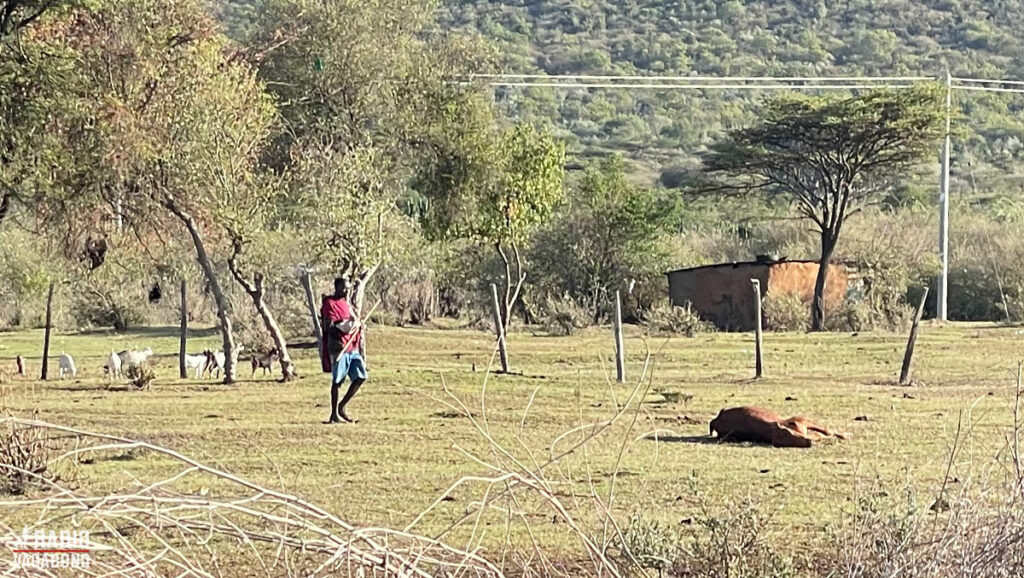
THEY LOST 400 COWS
The singing and the jumping were taking place just outside the fence that is built to protect their cattle at night from wild animals.
As we enter the village, Sammy tells me something that breaks my heart. Until recently, they had 500 cows in the village but lost 400 cows due to the drought. Let me just pause it first to put into context just how big a deal this is.
The Maasai people believe that cattle are the gods’ gift to them. They are semi-nomadic and move with their animals across the plains of Kenya and northern Tanzania, setting up home where they find the best grazing sites. Their cattle are the wealth of the village, units of currency, givers of milk to live, and on special occasions, meat and blood. Their lifestyle concentrates on their cattle which make up the primary food source. Amongst the Maasai the measure of a man’s wealth is in terms of children and cattle. So, the more, the better.
During the drought, there was not enough grass for the cows, and with that, no food for the Maasai, as they don’t grow any plants. As we continued walking, Sammy pointed to the field where I could see a dead cow carcass lying. It was indeed a sad sight.
The Maasai graze the cattle in the park at night which is a risky affair. We would see herds of cows heading to the national park for grazing during our nightly game drives. The warriors would lead the cows to greener pastures. However, there were light rains on our days there, which may be a good sign that there may be grass soon.
MAKING FIRE
The Maasai then teaches me how to make fire the old traditional way. They have a piece of flat wood (which he called the sandpaper tree) and a wooden stick. They place the wood on a machete on the ground and start spinning the stick with their hands and the tip of the stick in one of the holes. Three guys are sitting on their knees and take turns in spinning the stick.
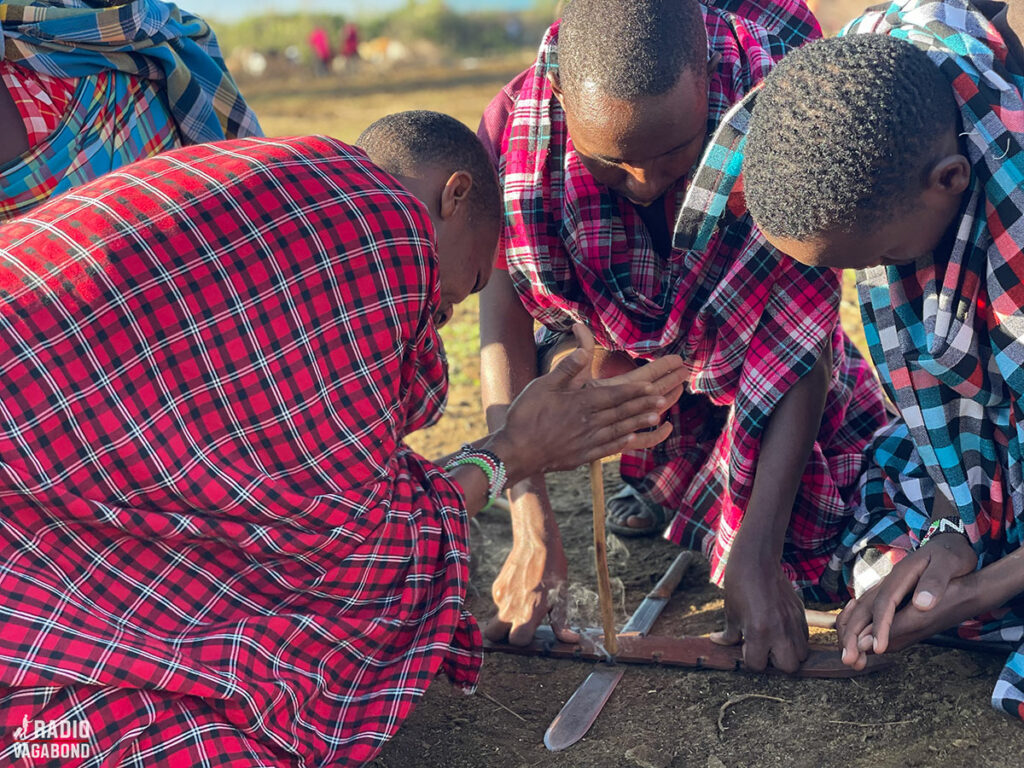
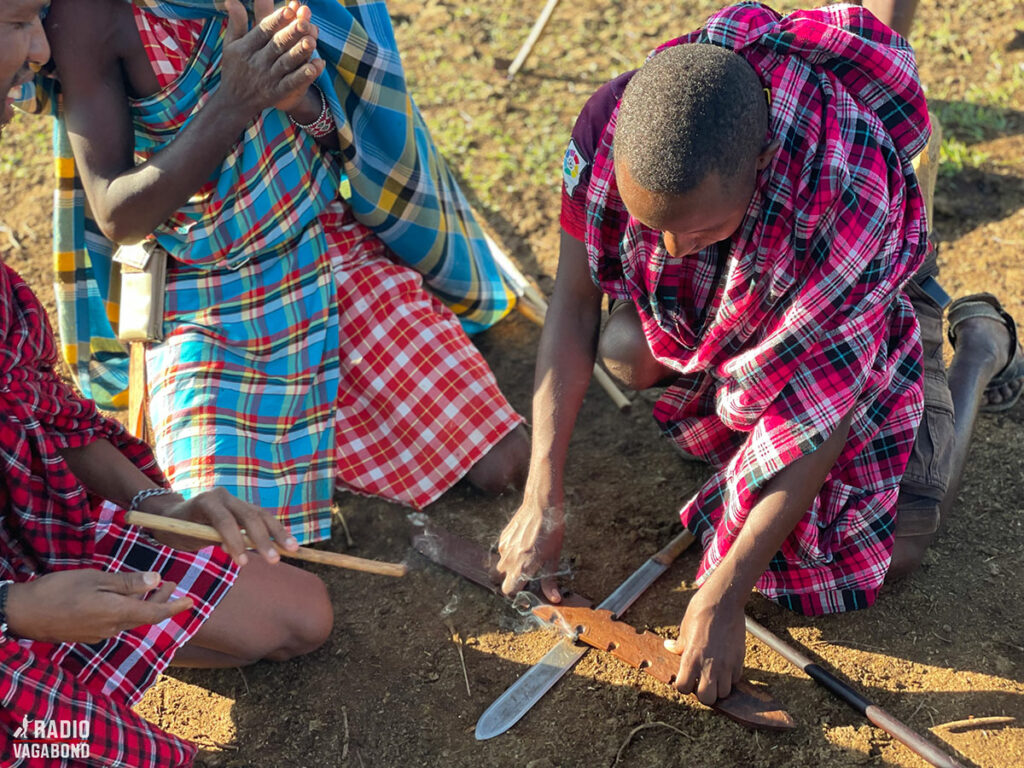

Surprisingly fast, smoke starts building from the friction point between the hard and the soft piece of wood. Sammy is standing ready with a handful of dried grass and cow dung – and at some point, they tip the glowing part first on the metal of the machete and then into the dried grass and dung.
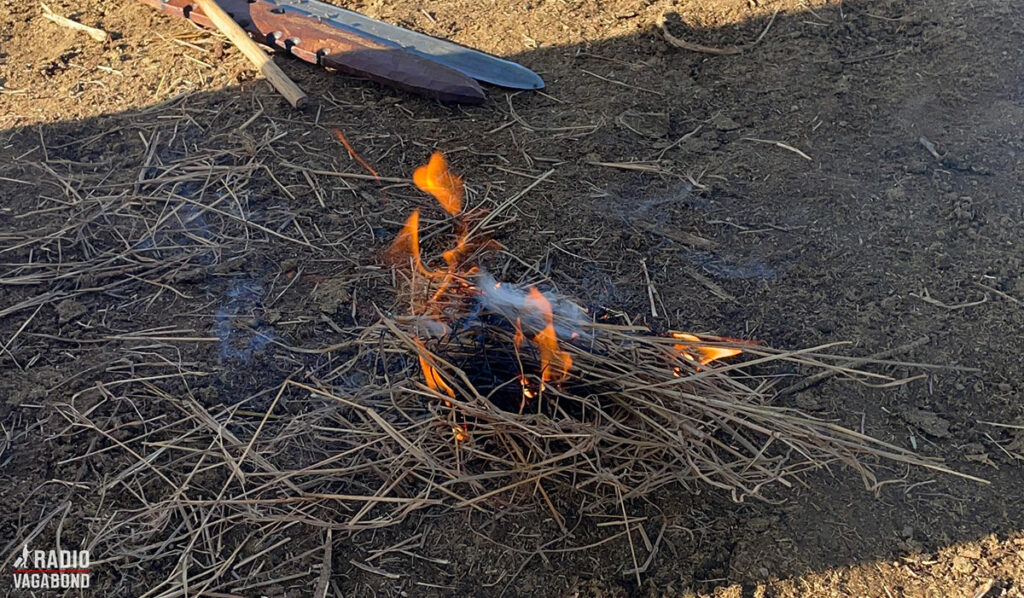
Sammy blows into it and the smoke is building. When we see fire, he puts it on the ground and says:
“So, now we make barbecue”.
They only make fire once every few years and keep it burning around the village. They also “borrow” fire from one house to another.
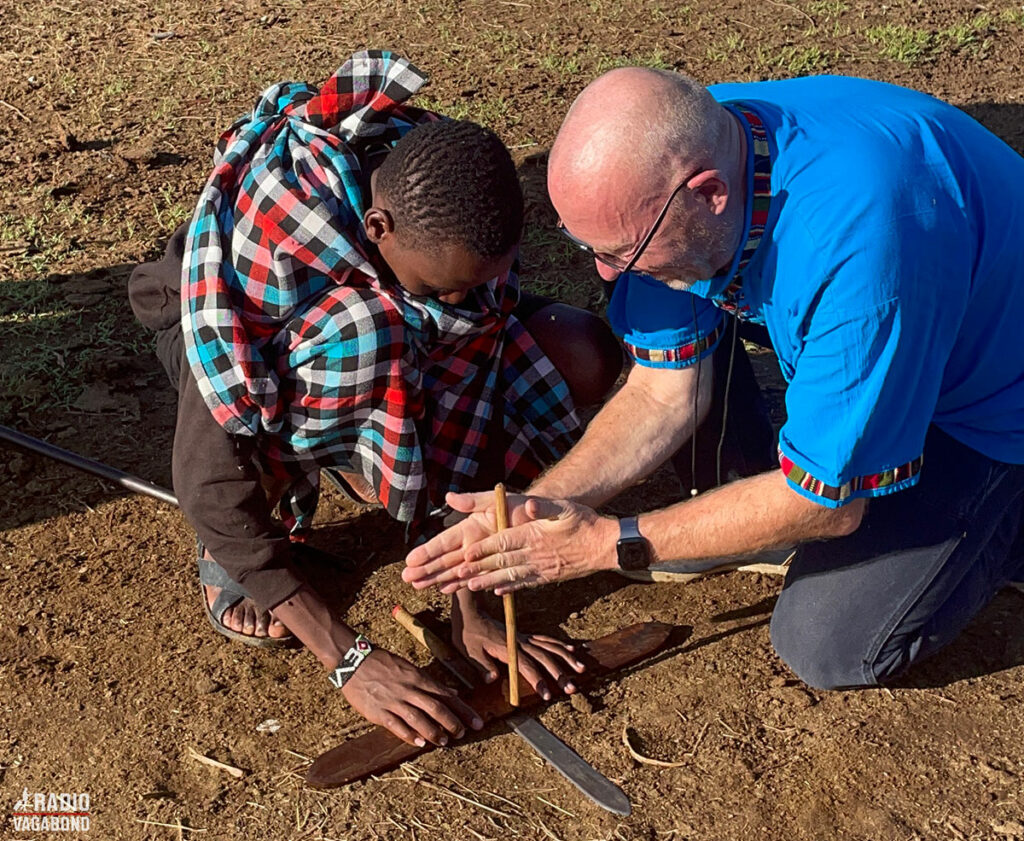
And then (of course), they ask me to try too… Did I make a fire? Well, naturally, I had a lighter in my pocket.
THE LITTLE HOUSE ON THE SAVANNAH
I get invited into Sammy’s family’s small hut made of wood and cow dung. The Maasai have to use readily available materials and indigenous technology to construct their unusual and interesting houses (Manyatta). They are built by women and take two months.
We enter the small house and take a seat in the main room, which is only 3 by 4 meters (10 by 12 feet). It serves as a bedroom, living room, and fireplace for the entire family. In the middle of the room is a fireplace, what functions as the kitchen where they cook.

DO THEY LIVE LONG LIVES?
As I’m sitting on the dirt floor of this small hut, smelling the smoke of the fireplace in front of me, it seems very primitive. And I can’t help thinking about how childbirth was given that they are so far away from hospitals and doctors.
It’s like Sammy is reading my mind and tells me that they have a medicine man and a midwife in the village. Sammy also tells me about natural medicine and even says that there are very few maternal deaths.
And then he tells me that his grandfather lived till the age of 122 years and his grandmother till she was 118 years old. According to Sammy, many Maasai people live for more than a century. I was a bit perplexed. Sammy was even more surprised when I told him that life expectancy in Denmark is 83 for women and 80 for men.
After my visit, I did a bit of research on life expectancy among the Maasai people. Was it true that they live as long as Sammy’s grandparents did? And no. According to a few different websites I’ve looked at, the average life expectancy for the Maasai people is the lowest in the whole world. The average male lives to the age of 42, and the women until the age of just 44.
Sammy was off when he said most people live up to 100 years. Or maybe his family just was lucky with his grandparents getting very old.

CHEERS IN THE LOCAL BREW
They offer me to try their local brew, which contains some of their herbal medicine and honey. I take a sip. It tasted good, and then Sammy and his brother (sitting next to me) told me to finish the cup. A little part of me is thinking: “What is this?” and “how is it made?” But I want to be polite, and what is the worst that could happen? So, bottoms up, Palle! I gulp down every drop, and they seem surprised and impressed.
They also have a little guest room in the hut, and Sammy promised to host me. So, now I have a free place to stay when I’m back in the village. I better go back there before they move so I can find them.
FULL OF CONTRASTS
As we walk around the village, it’s like going back in time. They are people who stick to the old traditions and refuse to bow down to western modernization.
But at the same time, a lot of them are walking around with smartphones. It’s a funny contrast to see. They make fire the hard way with sticks, sit on the dirt floor around a fireplace inside a little hut made out of wood and cow dung – but also have smartphones where they take selfies and engage on social media. The young man called Augustus ask me for my WhatsApp number.
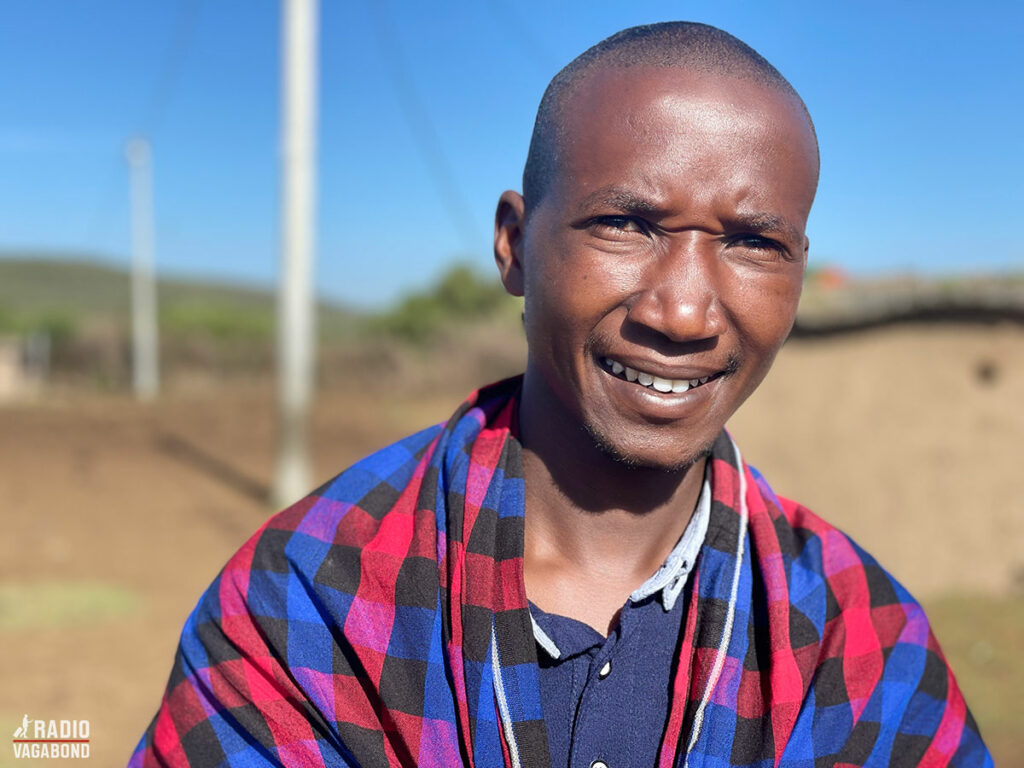
THE RADIO VAGABOND LANGUAGE SCHOOL:
MAA
It’s time to learn to speak a few words in their local Maasai language, Maa.
- Hello (supa)
- Thank you (ashe-oleng)
- Goodbye (olesere)
- How high can you jump? (E ging mabaa)
- Are you on WhatsApp? (Iitiyi WhatsApp?)
You can hear the pronunciation on the podcast – sent to me via WhatsApp from Augustus in the village.
FRIENDLY WARRIORS
The Maasai tribe is often described as one of the world’s largest (and last) great warrior cultures, but Sammy tells me they don’t have any fights or conflicts with the other Maasai villages. In fact, they help each other a great deal.
I paid a small fee to visit them, and at the end, Sammy asks me if I feel like giving a small donation to the village. The only cash I had left in my wallet was meant to be my tip to Dennis, our driver. But after spending time with the wonderful people and hearing about the hardship they are in right now with losing 400 cows, I give Sammy all I had, and as we’re heading back home to Nairobi later in the day, I tell Dennis that he has to stop by an ATM so that I can get cash for his tip.

SAY YES TO A MAASAI VISIT
If you ever go to The Masai Mara and are asked if you would like to visit a Maasai village, say yes! It was interesting, and they are such friendly, open, warm people.
While many African tribes have lost their traditions over time, the Maasai tribe is well known for its strong traditions, unique culture, and red tribal dress. The Maasai tribe truly is an inspiration as they stand firm in their traditional lifestyle – but still, they don’t go overboard and have smartphones.
AND THAT ALL, FOLKS
That’s almost the end of this four-part mini-series about what to see in Kenya and especially the Masai Mara. Again, thank you to Scenery Adventures for making the trip possible and to all the people I met here.
My name is Palle Bo, and I gotta keep moving. See you.
EMAIL FROM A LISTENER
I received an email from a listener. David from the UK.
Hi Palle,
I’ve travelled with work and vacation to perhaps 40 countries in 40 years, but with family illness, BREXIT, a career change, and then Covid, like many, we became rather stuck in a rut over the past few years.
I am married to a Dane, and we will be relocating to Denmark later this year. As part of our plans to shake up our lives, we are looking to get back on the road soon.
Yes, I enjoy your series vicariously, but it triggers thoughts and ideas of what to do next and provides the motivation to use our 4000 weeks on this planet wisely.
As an example of how you have affected change, our week-long trip to Croatia at Easter will now include a detour to Montenegro… because why not!
The podcasts are a perfect length, and the production is first-rate. I also find your honesty refreshing.
Keep up the good work!
Best wishes
David
Thanks, David. Great to know that I have inspired you to take a detour to Montenegro. I promise you that you will not be disappointed.
The Montenegro episode was number 175, and if you haven’t heard it, you should listen to that one too – after the rest of this one. Maybe you will be inspired too, like David and his wife.
I WOULD ALSO LIKE TO HEAR FROM YOU!
Please tell me where are you and what are you doing as you listen to this episode? You can either send me an email on listener@theradiovagabond.com, go to TheRadioVagabond.com/Contact or send me a voice message by clicking on the banner.

Either way, I would love to hear from you. It’s so nice to know who’s on the other end of this.
SPONSOR
A special thank you to my sponsor, Hotels25.com, who always provide me with the best, most affordable accommodation wherever I am in the world.
Hotels25 scans for prices on the biggest and best travel sites (like Booking.com, Hotels.com, Agoda and Expedia) in seconds. It finds deals from across the web and put them in one place. Then you just compare your options for the same hotel, apartment, hostel or home and choose where you book.
When you book with Hotels25, you get access to 5,000,000 hotel deals. And it’s “best price guaranteed.”
PRODUCED BY RADIOGURU
The Radio Vagabond is produced by RadioGuru. Reach out if you need help with your podcast.

